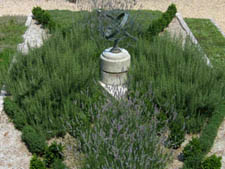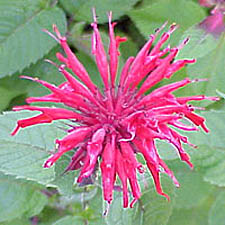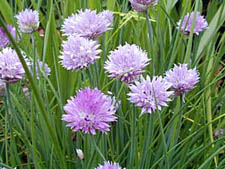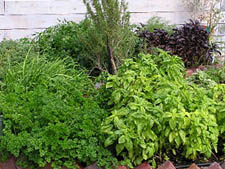
A formal English knot garden features standard herbs such as rosemary, oregano and thyme with a focal point, such as a sculpture, in the center.
Uses for Herbs
The most popular use for herbs is in cooking, and nearly every recipe can be enhanced with the addition of appropriate herbs. Can you imagine tomato sauce without oregano? Thanksgiving stuffing without sage? Some dishes are defined by the herbs they contain -- pesto without basil just isn't pesto!Herbs have many other uses as well. Many types make wonderful teas, either individually or combined in blends. Chamomile makes a soothing tea for unwinding after a hard day. Bee balm (Monarda) makes a tangy tea with citrus overtones. And in addition to being tasty, mint teas aid in digestion.
Many herbs are also believed to have medicinal properties. The echinacea that has become popular as a cold remedy is extracted from the purple coneflower, a common garden perennial.
Of course many gardeners grow herbs simply because they are attractive and durable plants. Bee balm not only makes a tasty tea, it is also a reliable perennial with lovely red, pink, or white flowers. And chamomile's daisy-like blooms brighten up any sunny border.

Bee balm (Monarda) is an attractive herb that butterflies and hummingbirds love as well. The flowers and leaves make an excellent tea.
Where to Plant
Plant herbs where you can get to them easily for frequent harvesting, especially if you plan to use them in cooking. Consider planting a special kitchen garden near the house, so you can readily harvest herbs, greens, and other frequently used crops. You can also grow herbs in containers or even window boxes.Most herbs prefer full sun -- at least 6 hours per day. Herbs that will tolerate some light shade include chives, cilantro, dill, and mint. Remember that if you plant perennial herbs in the vegetable garden, keep them in a separate section so you'll be sure to avoid them during spring and fall tilling.
Types of Herbs
Like all garden plants, herbs can be categorized as annual, perennial, or biennial. Annual plants grow for only one season and so must be planted each spring. Perennials live for several years. Their foliage dies back in the fall, but the roots overwinter and resume growth the following spring. And biennials grow for two years, growing foliage the first season, overwintering, then forming seeds and dying back at the end of the second season.Here are some examples of each type of herb.
Annual Herbs
- basil
- chamomile
- cilantro/coriander
- cumin
- dill
- fennel
Perennial Herbs*
- catnip
- chives
- lavender
- lemon balm
- lovage
- lemongrass
- marjoram
- mint
- oregano
- rosemary
- sage
- tarragon
- thyme
Parsley is one of the few common herbs that is a biennial. However, unless you want to harvest the seed, you can treat it like an annual and plant new plants each season.

Chives not only produce mild, onion-flavored leaves, the flowers are beautiful and edible as well.
Herb Garden Design
Herbs can be grown with other plantings or in their own garden. You can create a traditional, formal herb garden with two paths intersecting at the center to create four symmetrical gardens. Each section can feature herbs grouped by theme, such as culinary herbs, medicinal herbs, and aromatic herbs. Try to grow herbs with similar growing requirements together for easier maintenance. You can decorate the center intersection with a pot or urn filled with attractive herbs. The paths can be edged with landscape edging, bricks, stone, or even well- trimmed, woody herbs such as lavender.Even though a formal herb garden is attractive, most gardeners would rather mix herbs in with other flower or vegetable plantings or grow them in containers. When growing herbs with other plantings, be sure they have enough room to expand and won't get shaded by tall plants.
Herbs make great container plants. To grow herbs successfully in containers or window boxes, you'll need a pot that has adequate drainage holes. Use fresh potting soil each year and keep the container well watered and fertilized. Try different combinations such as purple-leaved basils mixed with creeping thyme, or silver-leafed sage planted with curled-leafed parsley. Large perennial herbs, such as rosemary and lavender, can have their own pot and be over wintered indoors in cold climates. You'll be amazed at how attractive and useful these potted herbs can be.
Soil Requirements
In general, herbs prefer a moderately rich soil. An overly rich soil (or excessive fertilizing) can lead to vigorous growth. However, many people find that the flavor of overfertilized herbs is bland, probably due to reduced essential oil content.Many culinary herbs, such as thyme and oregano, are of Mediterranean heritage and are accustomed to growing in gravely soils. The soil in your herb garden should have excellent drainage. If yours doesn't, consider growing your herbs in raised beds or containers.

Culinary herbs with different leaf textures and colors are best grown close to the house where they can be easily harvested and enjoyed for their beauty.
Caring for Herb Plants
Most herbs will thrive with about 1 inch of water a week, similar to other vegetable plants. Herbs in raised beds and containers will dry out more quickly than those planted directly in the garden and may need more frequent watering. Keep garden beds weeded, especially early in the season as plants are getting established. If you have fertile soil, you won't need to add much fertilizer to herbs grown in the garden. For those in containers, you'll need to add a dilute, complete fertilizer such as 10-10-10 to keep the leaves green and plants growing strong.Once established, most herb plants are remarkably resistant to insect and disease attack. The oils that give them their aroma and flavor likely evolve to repel pests. However, keep an eye out for insects such as aphids, and diseases such as powdery mildew.
Harvesting Herbs
Harvest herbs by cutting back a shoot to just above a leaf. This will both provide you with a harvest and encourage nice, bushy growth on the remaining plant. In general, an herb's flavor is most pronounced when it is harvested just before the plant begins to flower and in the morning when the essential oils are most concentrated.Tips
- Heavily harvested herb plants can look untidy. Consider interplanting herb beds with annual flowers to camouflage the trimmed plants.
- Herbs can provide important habitat for beneficial insects. Dill and fennel are two herbs beneficial insects particularly like.
- Perennial mints, including spearmint, applemint, and peppermint, are very vigorous and can become invasive. Rather than planting them directly in the garden, grow the plants in containers, then sink the containers into the garden. This will contain the roots and limit spreading.
- Perennial herbs that are not hardy in your region can be overwintered indoors, then brought back outdoors in the spring. For example, in USDA Zones 7 and colder, bring rosemary and lavender plants indoors in late fall. Maintain them in a cool, bright spot over the winter, and move them outdoors again in the spring. In USDA Zones 8 and warmer, rosemary and lavender can be left outdoors year-round.
Other Great Herb Stories
Herbs in a PotOverwintering Herbs
Herbes de Provence
Herbal Tea Recipe http://www.garden.org/ediblelandscaping/?page=herb-gardening
No comments:
Post a Comment